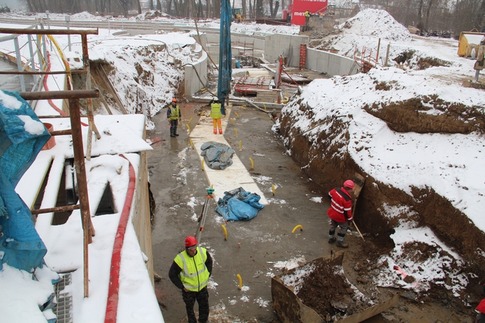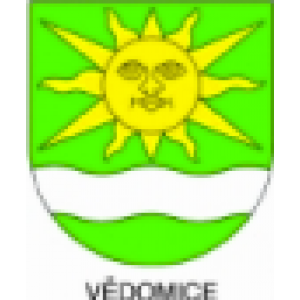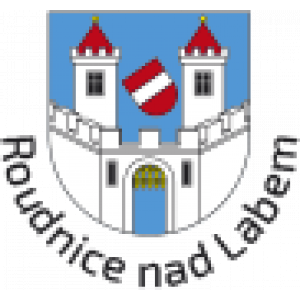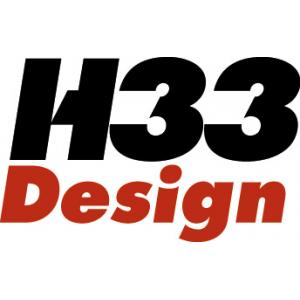The history of the slalom course
The racers of the canoeing division from Roudnice waited for over two years for the field that lied in the place of the original slalom course to grow into the new channel. Although the building process wall full of obstacles and setbacks, the canal was finally built, and the water is running as it should. We are presenting you the legendary canal of Roudnice made new!
The history of the Roudnice canal The first slalom canal in Roudnice was created in the sixties. The Spartak Roudnice nad Labem club (today’s Canoeing Club Roudnice) rented the original sluice gate from the Povodí Labe state enterprise for a symbolic price and rebuilt it into a slalom course on their own. Throughout the time and financial possibilities of the Club, the canal went through renovations and improvements.



However, the high incline and flow could not be used to the fullest, so the obstacles in the course were rebuilt many times. The obstacles on the canal’s bottom were usually made from concrete blocks but those were not safe due to their metal construction on their surface. Tires were another material used for obstacles. Most of the original obstacles remained in the canal to the day of its demolition. Even after many renovations made to the canal, its incline still could not be used to the fullest because of the significant part of a small elevation was lost in one particular place. This was caused by the original construction of the sluice gate.
The width of the canal was circa 12 metres. The elevation of average 2.3m was reached after 260 m which falls into the WW III difficulty class. However, this value was only theoretical. The water was turned on anytime people were training here.
Significant canal even outside the Czech Republic
At the canal in Roudnice, there used to be regular races in wild water sailing or slalom. For example, since 1981, there was Podřipský slalom race held every year. The artificial course also hosted the junior championship of the Czech Republic in slalom and sailing several times. In 1998 and 2008, there was also the world junior championship.
The first thoughts about the new canal The first suggestions to build a new canal were very different from today’s actual canal. There were also plans for a hydroelectric power plant that would mean demolishing the whole canal or its significant part. In the better case, the watermen would be remained with the rest of the canal that could be sailed only in specific hours. These plans, however, did not earn waterman’s trust and so they were never carried out.
Negotiations about the construction of a new canal succeeded with the company RenoEnergie that has canoeists in their lead. Despite the success, the negotiation took over two years full of dozens of meetings, hundreds of letters and phone calls. But everything aimed towards a happy ending and, finally, a mutual agreement with the Canoeing Club Roudnice was concluded. They agreed on the construction of a completely new modern slalom course. In the
case of late completion, wrong parameters or restriction of water running, the other side would face serious sanctions.
Construction of the new canal According to the plan, the construction of the canal in Roudnice should have been completed within almost two years, same as the hydroelectric power plant would take. However, the construction itself was postponed due to issues with the ROP (Regional Operational Programme) and the flood in 2013 also delayed the construction. The first test run of the course begun in July of this year, that is two and a half year after the beginning of the construction and especially after the closing and demolishing the original canal. Despite that, there was still one-year reserve until the last possible deadline for finishing the artificial slalom course. This deadline was set in case of various delays connected to building permit that was paradoxically acquired quickly.
The new canal and its funding Same as the hydroelectric power plant, the course was built in narrow and unfavourable conditions. The whole channel of the canal is equipped with rails for attaching English obstacles RapidBloc. There are in total almost 10 kilometres of rails on the bottom of the canal. Another expensive equipment of the artificial course is a transformable playspot (a cylinder used mainly by freestylers) or a gate that can be sailed over in any flow.


In case of an emergency, the gate is capable of closing the canal very quickly.
The artificial slalom course together with other facilities (pavement, bicycle path,…) cost in total almost 50 million CZK.
Same as for the canal in České Vrbné, the original funding of the canal in Roudnice should have come from the Regional Operational Programme. After putting together an extensive and complicated contract and before submitting a request, the ROP Severozápad was closed due to the wrong distribution of European funding. Despite that, the construction began, but with a delay. However, the long negotiations with restored ROP Severozápad were not heading towards a successful end. “The sad thing is that this is the way ROP Severozápad works. They return the money to the EU and give them to no one rather than explaining why they won't grant the funding to some project. The one who makes no mistakes, makes nothing,“ said Jakub Helus. Therefore, the whole funding was covered by RenoEnergie, a.s. with the support of a commercial loan by Česká spořitelna.
Author of the canal The author of the canal is RenoEnergie, a.s. – Jakub Helus who cooperated with Vojtěch Bareš, an experienced architect of slalom courses. The project was also consulted with the Canoeing Club Roudnice. The designer of the project was the design and engineering agency I.P.R.E by Jan Šinták and Vodní cesty, a.s. that have experience from designing the artificial course in Čunov. To optimize the arrangement of the obstacles, a 1:20 model was created by carpentry company VP Truhlářství s.r.o. from Pilsen. The model test canal allowed the water flow to be adjusted. It was powered by a big pump in Metrostav and by the electricity made in the running small hydroelectric power plant.
The biggest issues during the construction Before the construction, the biggest issues were ecologists who did not agree with cutting down trees. Because of that, the shape of the channel had to be changed several times,
especially in the upper part. The creation of the project for the artificial slalom course wasn’t without issues as well – the playspot and the gate took over a year to be perfected together with Vodní cesty, a.s.
The construction of the canal faced problems several times after that as well. During the digging, the machine experience unexpected collisions with the network. They also managed to disrupt the waterpipe several time and once they disrupted power for the whole Roudnice. It was also important to secure the Roudnice bridge and its foundation so the working happening in its surrounding went without a problem.
Another obstacle was the long wait for the Regional Operational Programme Severozápad and also the aforementioned flood in 2013. There were also problems with undelay and the construction of the upper part of the canal experienced water leakage. Even the original arrangement of the obstacles was not ideal, so the rebuilding took another week of the launch of the course.
Big plans for the future


Since Roudnice gathered experience in hosting races on the international level, people of Roudnice would like to continue with races of this scale on the future. As a first step towards this future, Roudnice held a freestyle race under the auspices of the Czech National Association of the Whitewater Rodeo. At the same time, there was also kayakcross. That is why there will be more of these kinds of race in the future. The playspot also attracts surfers and the high flow attracts rafters.
The original idea versus reality The authors of the course and especially the canoeists from the Canoeing Club Roudnice are very satisfied with the canal. The insufficient incline of just 2.5m is compensated by the high flow of up to 20 m3/s. This results in fast and wild water despite its low elevation. The obstacles are made and arranged in such way that they create waves, stoppers and eddies but they also don’t slow down the water. As the author of the canal, Jakub Helus, says: “We really did a good job on the canal but there are still few things that need to be adjusted.” The playspot also works very well despite it being maybe too much wild. But the ideas and plans about how to improve the call and underway.
Thanks for the cooperation and help with this article goes to Jakub Helus.
















